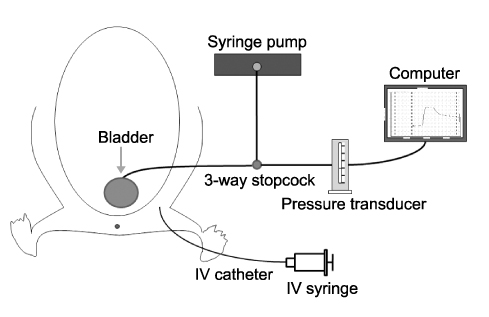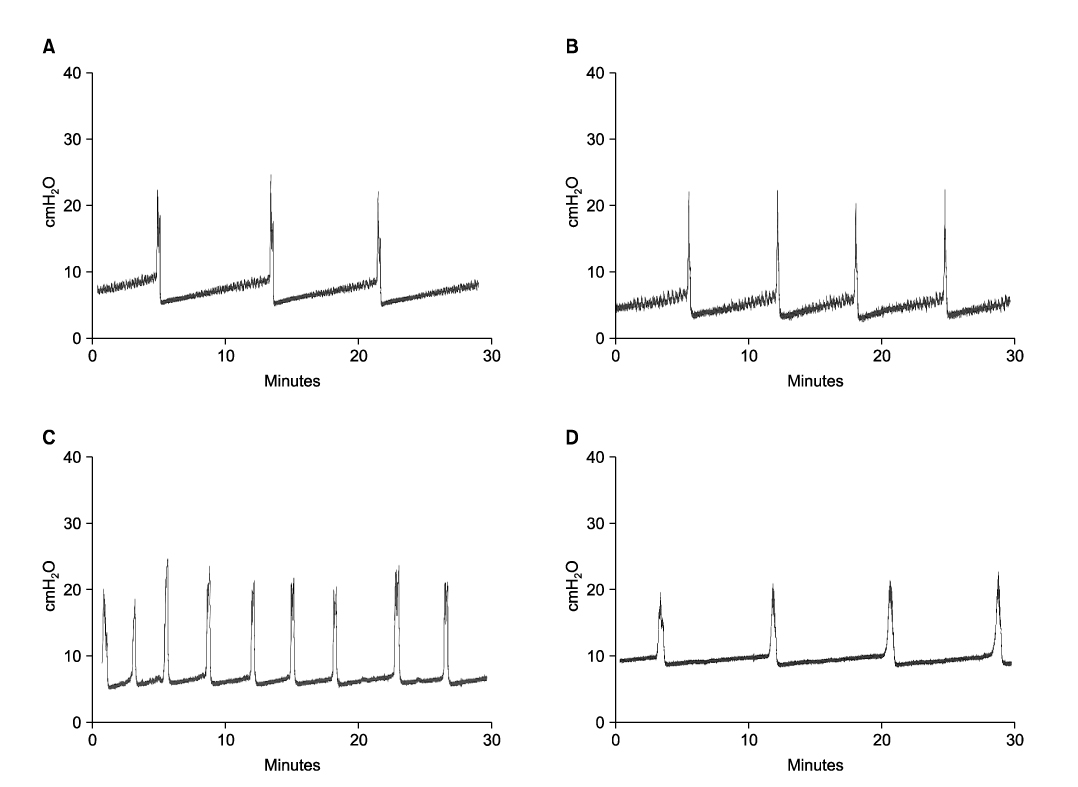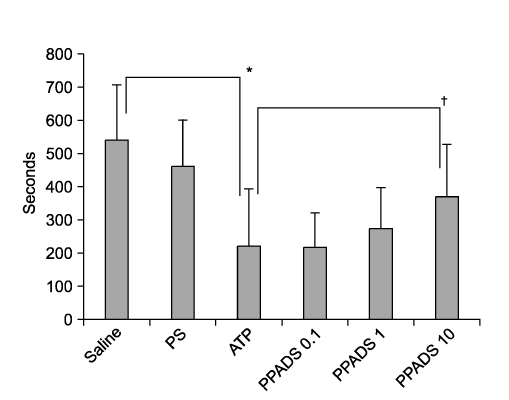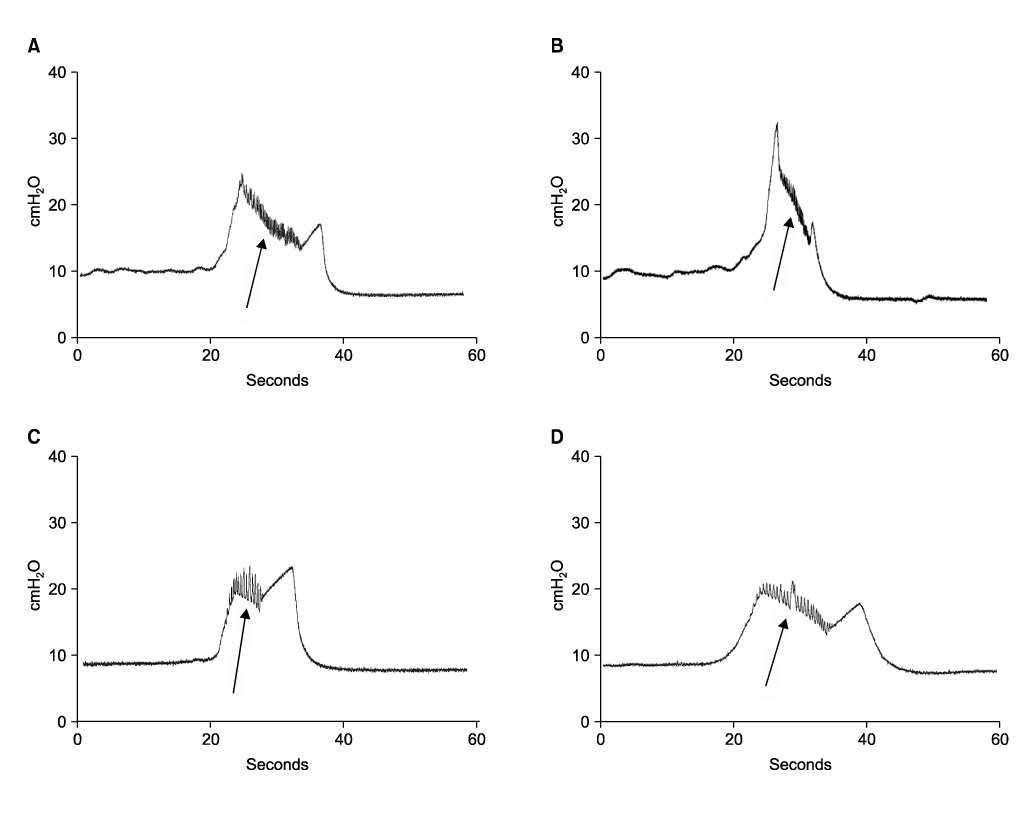Korean J Urol.
2008 May;49(5):424-431. 10.4111/kju.2008.49.5.424.
Characteristics of Detrusor Overactivity Induced by Intravesical Instillation of Adenosine 5'-Triphosphate
- Affiliations
-
- 1Department of Urology, College of Medicine, Hanyang University, Seoul, Korea. ytkimuro@hanyang.ac.kr
- KMID: 1204523
- DOI: http://doi.org/10.4111/kju.2008.49.5.424
Abstract
-
PURPOSE: The bladder urothelium releases adenosine 5'-triphosphate(ATP) with mechanical stretch, which increases in a pathologic state such as a neurogenic bladder. We investigated the characteristics of detrusor overactivity induced by the intravesical instillation of ATP.
MATERIALS AN METHODS: Under urethane anesthesia, cystometry was performed on female Sprague-Dawley rats. After pretreatment with protamine sulfate(PS, 10mg/ml), ATP(60mM, pH 6.0) was continuously infused intravesically. The effects of intravenous injection of pyridoxalphosphate-6-azophenyl-2',4'-disulphonic acid(PPADS) on ATP-induced detrusor overactivity were studied. Changes in cystometric parameters including parameters of each voiding phase, including bladder pressure increase rate(slope; Ph1slope), maximal bladder pressure(Ph1MBP, Ph2MBP, Ph3MBP), mean bladder pressure(Ph2meanBP) and variation of intraluminal pressure high-frequency oscillations(IPHFOs) were analysed.
RESULTS
With the intravesical instillation of ATP after PS pretreatment, the intercontraction interval(ICI) decreased significantly(544.2+/-167.2s vs 222.3+/-170.8s, p=0.001), maximal voiding pressure(MVP) decreased significantly(31.3+/-4.7cmH2O vs 25+/-2.9cmH2O, p=0.001), and pressure threshold (PT) decreased significantly(4.0+/-1.3cmH2O vs 1.4+/-0.8cmH2O, p=0.001). Changes in the ICI, MVP & PT induced by intravesical instillation of ATP were reversed by intravenous injection of PPADS. Ph1slope, Ph1MBP, Ph2MBP, Ph2meanBP and Ph3MBP were decreased, but IPHFOs were not affected by intravesical application of ATP.
Conclusions
Intravesical instillation of ATP in female rats induced detrusor overactivity, which may be mediated by acting on the urine storage phase.
Keyword
Figure
Reference
-
1. Maggi CA. Nervous control of the urogenital system. 1993. London: Harwood Academic Publishers;227–289.2. Masuda H, Kim YT, Tyagi S, Chancellor MB, de Miguel F, Yoshimura N. Local effects of antimuscarinics. Urol Clin North Am. 2006. 33:511–518.3. Salas NA, Somogyi GT, Gangitano DA, Boone TB, Smith CP. Receptor activated bladder and spinal ATP release in neurally intact and chronic spinal cord injured rats. Neurochem Int. 2007. 50:345–350.4. Kim JC, Yoo JS, Park EY, Hong SH, Seo SI, Hwang TK. Muscarinic and purinergic receptor expression in the urothelium of rats with detrusor overactivity induced by bladder outlet obstruction. BJU Int. 2008. 101:371–375.5. Dang K, Lamb KR, Cohen M, Bielefeldt K, Gebhart GF. Cyclophosphamide-induced bladder inflammation sensitizes and enhances P2X receptor function in rat bladder sensory neurons. J Neurophysiol. 2008. 99:49–59.6. Ozawa H, Chancellor MB, Jung SY, Yokoyama T, Fraser MO, Yu Y, et al. Effect of intravesical nitric oxide therapy on cyclophosphamide-induced cystitis. J Urol. 1999. 162:2211–2216.7. Cetinel S, Ercan F, Sirvanci S, Sehirli O, Ersoy Y, San T, et al. The ameliorating effect of melatonin on protamine sulfate induced bladder injury and its relationship to interstitial cystitis. J Urol. 2003. 169:1564–1568.8. Zeybek A, Cikler E, Saglam B, Ercan F, Cetinel S, Sener G. Aqueous garlic extract inhibits protamine sulfate-induced bladder damage. Urol Int. 2006. 76:173–179.9. Stein PC, Pham H, Ito T, Parsons CL. Bladder injury model induced in rats by exposure to protamine sulfate followed by bacterial endotoxin. J Urol. 1996. 155:1133–1138.10. Kim Y, Yoshimura N, Masuda H, De Miguel F, Chancellor MB. Intravesical instillation of human urine after oral administration of trospium, tolterodine and oxybutynin in a rat model of detrusor overactivity. BJU Int. 2006. 97:400–403.11. Nishiguchi J, Hayashi Y, Chancellor MB, de Miguel F, de Groat WC, Kumon H, et al. Detrusor overactivity induced by intravesical application of adenosine 5'-triphosphate under different delivery conditions in rats. Urology. 2005. 66:1332–1337.12. de Groat WC. The urothelium in overactive bladder: passive bystander or active participant? Urology. 2004. 64:6 Suppl 1. 7–11.13. Andersson KE, Hedlund P. Pharmacologic perspective on the physiology of the lower urinary tract. Urology. 2002. 60:5 Suppl 1. 13–20.14. Zhang X, Igawa Y, Ishizuka O, Nishizawa O, Andersson KE. Effects of resiniferatoxin desensitization of capsaicin-sensitive afferents on detrusor over-activity induced by intravesical capsaicin, acetic acid or ATP in conscious rats. Naunyn Schmiedebergs Arch Pharmacol. 2003. 367:473–479.15. Atiemo H, Wynes J, Chuo J, Nipkow L, Sklar GN, Chai TC. Effect of botulinum toxin on detrusor overactivity induced by intravesical adenosine triphosphate and capsaicin in a rat model. Urology. 2005. 65:622–626.16. Streng T, Talo A, Andersson KE. Transmitters contributing to the voiding contraction in female rats. BJU Int. 2004. 94:910–914.17. Pandita RK, Andersson KE. Intravesical adenosine triphosphate stimulates the micturition reflex in awake, freely moving rats. J Urol. 2002. 168:1230–1234.18. Nishiguchi J, Sasaki K, Seki S, Chancellor MB, Erickson KA, de Groat WC, et al. Effects of isolectin B4-conjugated saporin, a targeting cytotoxin, on bladder overactivity induced by bladder irritation. Eur J Neurosci. 2004. 20:474–482.19. Gillespie JI. Modulation of autonomous contractile activity in the isolated whole bladder of the guinea pig. BJU Int. 2004. 93:393–400.20. de Groat WC. A neurologic basis for the overactive bladder. Urology. 1997. 50:6A Suppl. 36–52.21. Ifshin MS, Johnson KE, Eaton DC. Acid pH and weak acids induce Na-Cl cotransport in the rabbit urinary bladder. J Membr Biol. 1983. 76:151–164.22. Hoheisel U, Reinohl J, Unger T, Mense S. Acidic pH and capsaicin activate mechanosensitive group IV muscle receptors in the rat. Pain. 2004. 110:149–157.23. Grycova L, Lansky Z, Friedlova E, Vlachova V, Kubala M, Obsilova V, et al. ATP binding site on the C-terminus of the vanilloid receptor. Arch Biochem Biophys. 2007. 465:389–398.24. Vlaskovska M, Kasakov L, Rong W, Bodin P, Bardini M, Cockayne DA, et al. P2X3 knock-out mice reveal a major sensory role for urothelially released ATP. J Neurosci. 2001. 21:5670–5677.25. Ferguson DR, Kennedy I, Burton TJ. ATP is released from rabbit urinary bladder epithelial cells by hydrostatic pressure changes-a possible sensory mechanism? J Physiol. 1997. 505:503–511.26. Ziganshin AU, Hoyle CH, Bo X, Lambrecht G, Mutschler E, Baumert HG, et al. PPADS selectively antagonizes P2Xpurinoceptor-mediated responses in the rabbit urinary bladder. Br J Pharmacol. 1993. 110:1491–1495.27. Ruggieri MR Sr. Mechanisms of disease: role of purinergic signaling in the pathophysiology of bladder dysfunction. Nat Clin Pract Urol. 2006. 3:206–215.28. Yiangou Y, Facer P, Ford A, Brady C, Wiseman O, Fowler CJ, et al. Capsaicin receptor VR1 and ATP-gated ion channel P2X3 in human urinary bladder. BJU Int. 2001. 87:774–779.29. Sun Y, Keay S, De Deyne PG, Cai TC. Augmented stretch activated adenosine triphosphate release from bladder uroepithelial cells in patients with interstitial cystitis. J Urol. 2001. 166:1951–1956.30. Slobodov G, Feloney M, Gran C, Kyker KD, Hurst RE, Culkin DJ. Abnormal expression of molecular markers for bladder impermeability and differentiation in the urothelium of patients with interstitial cystitis. J Urol. 2004. 171:1554–1558.
- Full Text Links
- Actions
-
Cited
- CITED
-
- Close
- Share
- Similar articles
-
- Effects of Intravesical Instillation of Antimuscarinics on Bladder Overactivity Induced by Intravesical Instillation of Adenosine Triphosphate in Rats
- Intravesical PGE2 Administration in Conscious Rats as an Experimental Model of Detrusor Overactivity Observed by Simultaneous Registrations of Intravesical and Intraabdominal Pressures
- Physiologic and Pathophysiologic Functions of Purinoceptors in Voiding Reflex
- The Different Mechanisms of Awake Micturitions between Male and Female Rats Using an Overactive Model with Intravesical PGE2 Instillation
- Urodynamic Findings in an Awake Chemical Cystitis Rat Model Observed by Simultaneous Registrations of Intravesical and Intraabdominal Pressures






